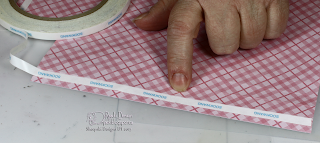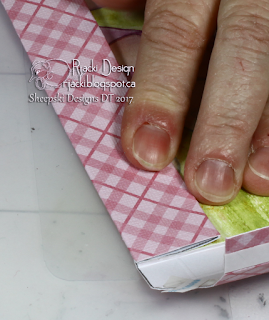For this full project, I have quite a lot of pictures showing the process from painting the image to making the shadowbox frame. I divided it into three posts. I hope you want to join me in all three.
This post showcases the details of the shadowbox frame construction for a project featuring a digital stamp by SheepSki Designs.
For the main post: http://rijacki.blogspot.com/2017/03/bubbles.html
For the colouring/painting details: http://rijacki.blogspot.com/2017/03/bubbles-painting.html
Supplies for the full project
Creating the Shadowbox frame
The shadowbox frame was crafted using a 12" x 12" sheet of cardstock, a Scor-Pal board, a pair of scissors, and adhesive. This process creates an 8" x 8" shadow box with 7" x 7" interior area.
The Core'dinations sheet came with a tag section above the 12 inches.
I used a paper trimmer to trim off the tag and make the sheet 12" x 12".
This sheet is patterned on one side and white on the other. With the patterned side up, I
scored each side at 1/2", 1", 1 1/2", and 2".
The Core'dinations sheet came with a tag section above the 12 inches.
I used a paper trimmer to trim off the tag and make the sheet 12" x 12".
This sheet is patterned on one side and white on the other. With the patterned side up, I
scored each side at 1/2", 1", 1 1/2", and 2".
Four even score lines on each side. I find it easier to just turn the sheet around four times than to score from each side.
One of the most important lines is also the easier to nearly forget. On two sides, I made a short score at 2 1/2" and 9 1/2" from the outside, stopping at the second score line previously made. This was the last of the scores, I put the Scor-pal away.
Flipping the sheet, I took a pencil to draw up the short line in one of the corners.
Then diagonal across the square toward the corner.
Over 1 square.
Then down all four.
This gets repeated in mirror on the other corner of that side and then on the other side.
Cut along the pencil mark on all four corners. While it is possible to just cut and not draw on the cut lines, it's much easier to erase pencil if you boo-boo than to reattach an accidental cut.
After making the cuts, the sheet looks like this.
This is the point to train the folds. With the white side up, I folded on the score lines and used a bone folder to make the edges crisp.
I dry fit the image into the shadowbox frame. This is the first point I got a tangible look at how the finished project would look. Before this, I had to picture it in my head. I turned the sides and held them in place to get my glimpse to the future.
Since the image panel is a touch smaller than 8" x 8", I would need to add the picture to the inside before folding in the sides.
I added adhesive to the back of the image panel and adhered it to the back of the shadowbox in progress. I added it at this point because it would be too easy to forget after the next set of steps.
I will admit that this cardstock wasn't my first choice for the shadowbox frame. I went beyond this point without putting the picture in and did a forehead slap when I went to a step I couldn't back out and made it so I couldn't add the picture. But.. I think that flub actually improved the project. I hadn't looked at this paper until I flubbed the other and this is better.
I added Scor-tape to each side next to the last score mark. Using an adhesive tape for the shadowbox is better than tape runner because of the release paper. It lets you control the stickiness for placement.
I used a bone folder to firmly attach the adhesive tape.
On the flip side, I added a small piece of adhesive tape to each diagonal. This is the miter and will hod it in place.
To make easier to handle the diagonal adhesive, I removed the release paper and turned it 90 degrees to be like a flag sticking out. You'll see why this is handy in a few more steps.
From the long sides, the side without an angle cut, I removed the release to expose the adhesive.
Folding the side in half at the middle helps for placement in the next step.
Folding the side over again puts the adhesive in the exact right place.
Running a bone folder on the folded over side makes sure the adhesive is well adhered.
Rolling the side up, the well trained folds make it into a square tube with the adhesive firmly attached at the bottom.
This is repeated exactly the same on the other side.
Creating the tubes on the last two sides is a bit more tricky. To help with the adhesive placement, I removed the release and clipped it into smaller strips to use as flags, pointing toward the folds.
I lined up the inside edge of the side with the forth score and st the side of the image panel.
I rolled the side down, fitting. The adhesive flags help to control the adhesive strip.
I continue the roll to a tight fit on the corners.
The release flags easily slide out. The adhesive remains a bit loose and repositional until it is pressed down.
Before pressing firmly on the side I just rolled and deflagged, I took off the flags from the miters in the corners.
A small adjustment, as necessary, to make sure the corners are tight and then a bone folder over the miter edge and to press down on that whole side.
Repeated on the last side to finish the shadowbox frame.
The image, Bubble Dreams, is a digital stamp from SheepSki Designs.
I stamped the back of the shadowbox with one of my maker-mark stamps. I should have stamped it before assembling the sides but.. I never think about makers mark until I finish. This one is cute. It says "Handmade in British Columbia" and that's an outline of the province. I live in BC and this is handmade. When I found that stamp I just had to get it *grin*
If you want to see how the picture was painted, check out this post: http://rijacki.blogspot.com/2017/03/bubbles-painting.html
This project was made as an introduction to me as one of Sheepski Designs newest members of challenge blog design team.
I started papercrafting a little bit more than a year ago. My spiral into papercrafting started because I bought a Big Shot to augment metal working for jewelry crafting and to make things to put into resin which is another passion of mine.
I started making jewelry 4 and half years ago, shortly before I moved from the San Francisco area of California to the Vancouver area of British Columbia, Canada. Yup, just the hobby to start before an international move, one with lots of little pieces.
From beading, cord braiding (Kumihimo!), and some metal stamping, I discovered the fun of working with epoxy clay and resin. As I mentioned above, I originally got the Big Shot to augment resin and jewelry work and.. umm.. discovered the black hole world of dies! Oh.. umm.. yeah... then I found rubber stamps to love and started colouring. About a year ago I got a set of Chameleon pens and.. well.. I like them, but, then I discovered waterbrushes with Distress Ink and, yeah, that was that. I found my medium.
I'm still exploring various papercrafting techniques to expand my "bag of tricks". I like doing creative things and challenging myself.





































































Great step by step Rijacki, i'll have to have a go at this myself some time :)
ReplyDeleteAndrea x
SheepSki Designs